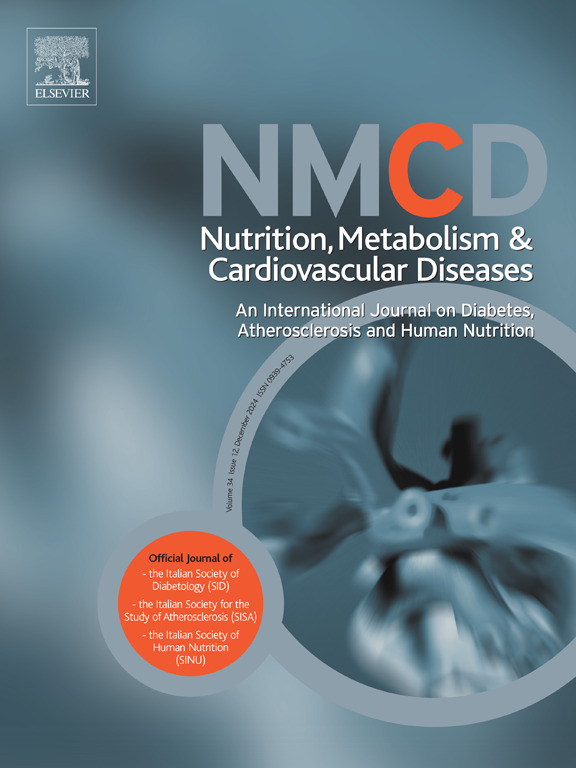Causal effects and mediating pathways of metabolic dysfunction-associated fatty liver disease on novel subtypes of adult-onset diabetes: A two-step Mendelian randomization study
IF 3.3
3区 医学
Q2 CARDIAC & CARDIOVASCULAR SYSTEMS
Nutrition Metabolism and Cardiovascular Diseases
Pub Date : 2025-03-11
DOI:10.1016/j.numecd.2025.103976
引用次数: 0
Abstract
Background and aim
Based on an in-depth understanding of diabetes heterogeneity, five novel subtypes of adult-onset diabetes have been identified. This study investigates the differential impact of metabolic dysfunction-associated fatty liver disease (MAFLD) on these subtypes using a Mendelian randomization (MR) approach, while also exploring modifiable mediating factors.
Methods and results
Genetic variants associated with MAFLD were selected at the genome-wide significance threshold (P < 5 × 10−8), with 16 variants used to assess causal associations with the risk of severe autoimmune diabetes (SAID), mild obesity-related diabetes (MOD), severe insulin-resistant diabetes (SIRD), severe insulin-deficient diabetes (SIDD), and mild age-related diabetes (MARD). Two-step MR was used to estimate total, direct, and mediated effects, analyzing 55 potential mediators across five domains. The primary method used was inverse variance weighting (IVW) along with a series of sensitivity analyses to ensure robustness of the results. Genetically predicted MAFLD was significantly associated with increased risk of MARD (OR = 1.171, 95 % CI 1.091–1.256), SIDD (OR = 1.158, 95 % CI 1.056–1.270), and SIRD (OR = 1.267, 95 % CI 1.119–1.434), with suggestive evidence for SAID (OR = 1.161, 95 % CI 1.016–1.327), but no association with MOD. Among all subtypes, waist-to-hip ratio adjusted for BMI (WHRadjBMI) was a common mediator, with liver fat, alanine aminotransferase (ALT), gamma-glutamyl transferase, fasting insulin (FI), and BMI mediating at least three subtypes. Liver fat accounted for the largest proportion of mediation (43.63 %–73.09 %), followed by ALT (8.99 %–17.93 %) and FI (6.81 %–13.04 %).
Conclusion
This study underscores the causal relationship between MAFLD and specific diabetes subtypes, highlighting the importance of integrated management of liver lipid metabolism, abdominal obesity, and blood glucose regulation. These findings support personalized intervention strategies.
代谢功能障碍相关脂肪性肝病对新型成人发病糖尿病的因果效应和介导途径:一项两步孟德尔随机化研究
背景与目的:基于对糖尿病异质性的深入了解,已经确定了五种新的成人发病糖尿病亚型。本研究使用孟德尔随机化(MR)方法研究了代谢功能障碍相关脂肪肝(MAFLD)对这些亚型的差异影响,同时也探索了可改变的中介因素。方法和结果:在全基因组显著性阈值(P -8)下选择与MAFLD相关的遗传变异,其中16个变异用于评估与严重自身免疫性糖尿病(SAID)、轻度肥胖相关糖尿病(MOD)、严重胰岛素抵抗型糖尿病(SIRD)、严重胰岛素缺乏型糖尿病(SIDD)和轻度年龄相关糖尿病(MARD)风险的因果关系。两步磁共振用于估计总、直接和中介效应,分析了5个领域的55个潜在中介。使用的主要方法是逆方差加权(IVW)以及一系列敏感性分析,以确保结果的稳健性。遗传预测的MAFLD与MARD (OR = 1.171, 95% CI 1.091-1.256)、SIDD (OR = 1.158, 95% CI 1.056-1.270)和SIRD (OR = 1.267, 95% CI 1.119-1.434)的风险增加显著相关,与SAID (OR = 1.161, 95% CI 1.016-1.327)相关,但与MOD无关。在所有亚型中,经BMI调整的腰臀比(WHRadjBMI)是常见的调节因子,肝脂肪、丙氨酸转氨酶(ALT)、γ -谷氨酰转移酶、空腹胰岛素(FI)、BMI介导至少三种亚型。肝脏脂肪所占中介比例最大(43.63% ~ 73.09%),其次是ALT(8.99% ~ 17.93%)和FI(6.81% ~ 13.04%)。结论:本研究强调了MAFLD与特定糖尿病亚型之间的因果关系,强调了肝脏脂质代谢、腹部肥胖和血糖调节综合管理的重要性。这些发现支持个性化干预策略。
本文章由计算机程序翻译,如有差异,请以英文原文为准。
求助全文
约1分钟内获得全文
求助全文
来源期刊
CiteScore
6.80
自引率
2.60%
发文量
332
审稿时长
57 days
期刊介绍:
Nutrition, Metabolism & Cardiovascular Diseases is a forum designed to focus on the powerful interplay between nutritional and metabolic alterations, and cardiovascular disorders. It aims to be a highly qualified tool to help refine strategies against the nutrition-related epidemics of metabolic and cardiovascular diseases. By presenting original clinical and experimental findings, it introduces readers and authors into a rapidly developing area of clinical and preventive medicine, including also vascular biology. Of particular concern are the origins, the mechanisms and the means to prevent and control diabetes, atherosclerosis, hypertension, and other nutrition-related diseases.

 求助内容:
求助内容: 应助结果提醒方式:
应助结果提醒方式:


